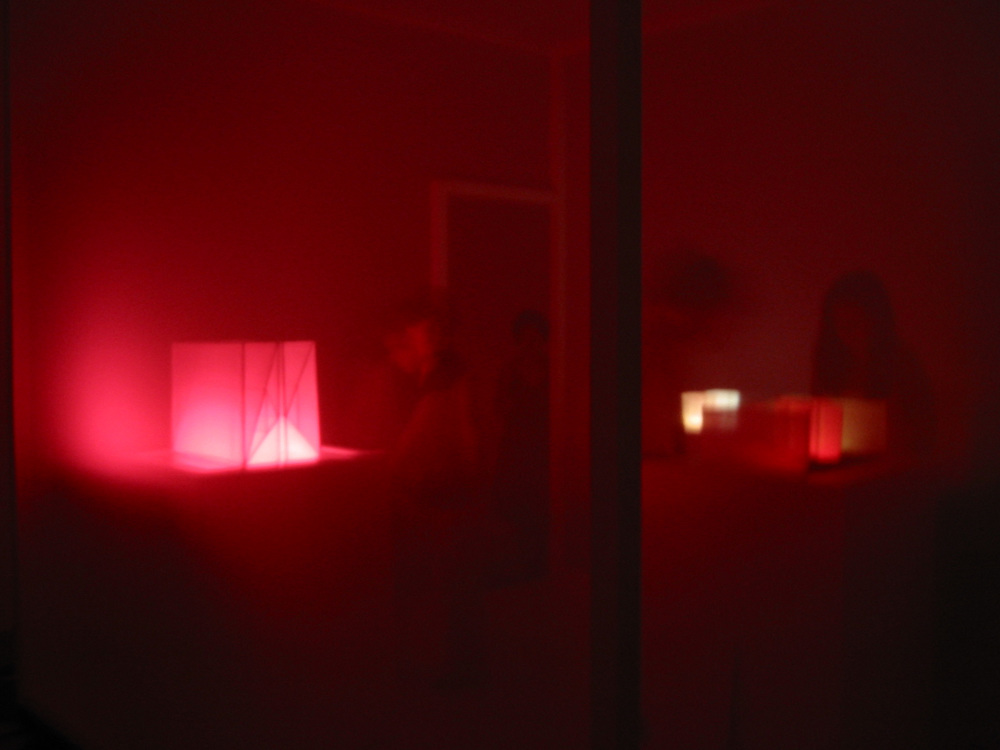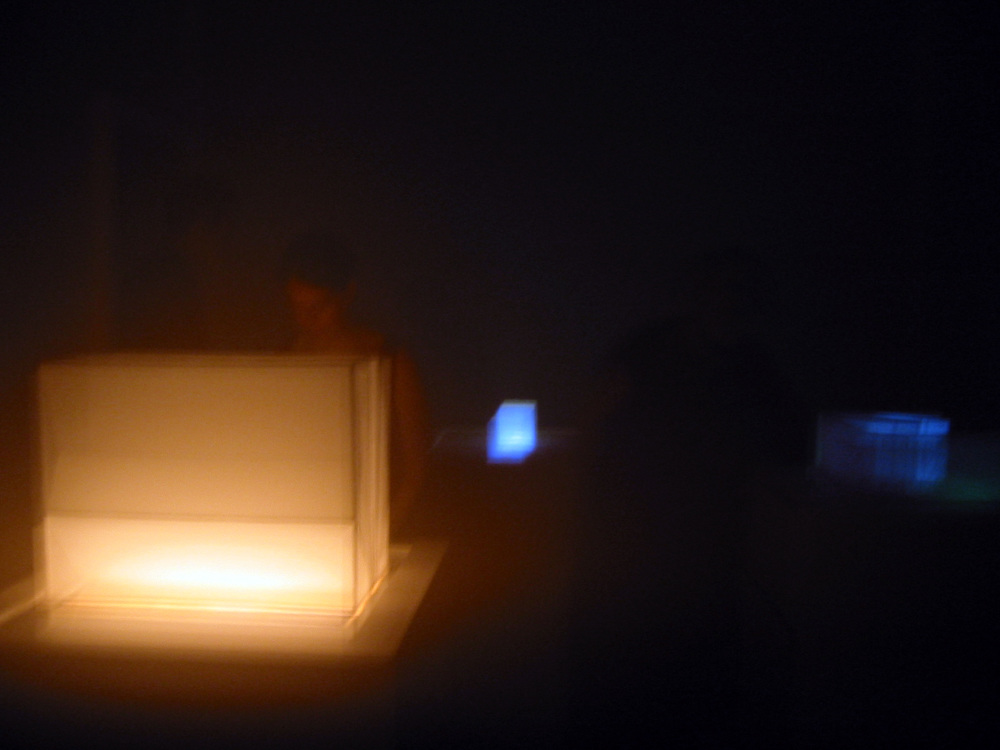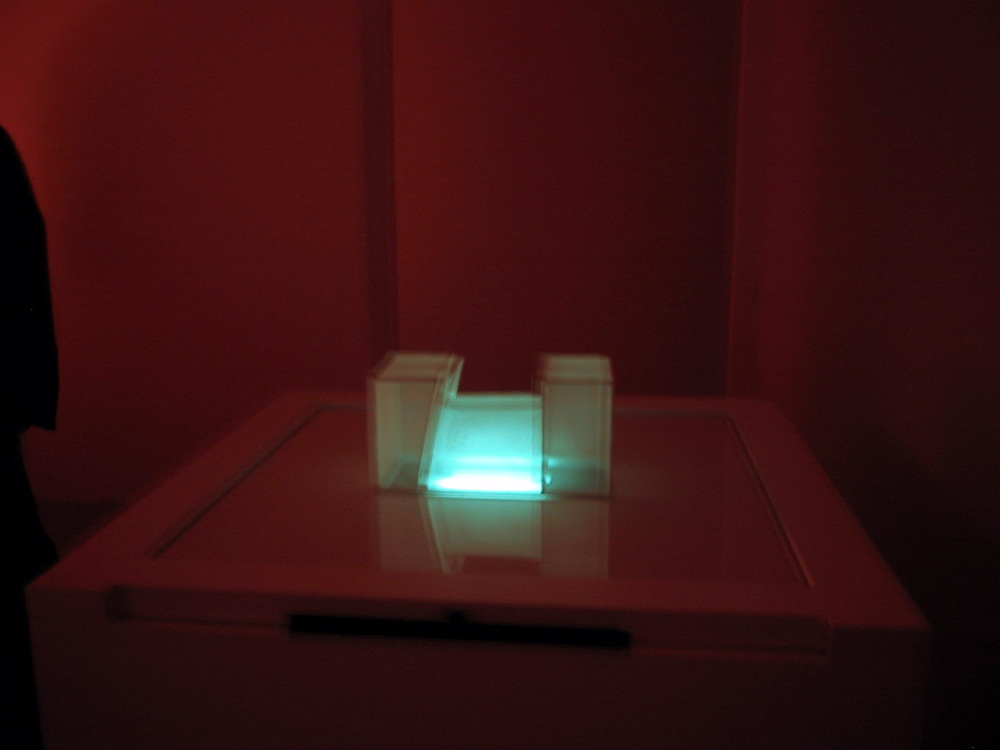

Perceptible 1
Metal, fabric, light bulbs, and wood
305 x 305 x 305 cm (approx.)
120 x 120 x 120 in (approx.)
Rio de Janeiro, 2002
The first installation of the Perceptible series is comprised of interdependent elements that are prepared to sequentially react to the intervention of the spectator. The gallery is occupied by a white cube structure that has all its walls covered with a white fabric that becomes transparent or translucent depending on its contact/proximity with light. In the opposite side to the gallery entrance there’s an entrance to the cube, inside the cube there are three cabinet structures each of them with four drawers. On top of the cabinets there are three white geometric objects that also have been covered with the same kind of fabric as the outer cube. The cabinets, besides being the base for the objects placed on top, are also light boxes, at their top there are openings that coincide with the bottom shapes of the objects. Inside each of the four drawers of each cabinet there’s a plate that has been cut out in some of the same shapes of the bottom of a specific object, and in each plate those shapes are covered with colorful transparent plastics.
Metal, fabric, light bulbs, and wood
305 x 305 x 305 cm (approx.)
120 x 120 x 120 in (approx.)
Rio de Janeiro, 2002
The first installation of the Perceptible series is comprised of interdependent elements that are prepared to sequentially react to the intervention of the spectator. The gallery is occupied by a white cube structure that has all its walls covered with a white fabric that becomes transparent or translucent depending on its contact/proximity with light. In the opposite side to the gallery entrance there’s an entrance to the cube, inside the cube there are three cabinet structures each of them with four drawers. On top of the cabinets there are three white geometric objects that also have been covered with the same kind of fabric as the outer cube. The cabinets, besides being the base for the objects placed on top, are also light boxes, at their top there are openings that coincide with the bottom shapes of the objects. Inside each of the four drawers of each cabinet there’s a plate that has been cut out in some of the same shapes of the bottom of a specific object, and in each plate those shapes are covered with colorful transparent plastics.
Created over the course of 10 years (between 2002 and 2011), the Perceptible series followed and reflected significant changes in Gustavo Prado’s work, particularly regarding the viewer’s perception and the relationship between the artwork and space. Perceptible Sundial (2002) is the first work in the series and is presented as a cube (considered one of the simplest forms for human recognition), made with a wooden structure and covered with fabric and paper. Its relatively simple form becomes complex in its interaction with space (and time). Aspects such as the place where it is positioned, and the natural light that shines upon it (which changes throughout the day and from one day to the next), influence characteristics such as viewing angles, transparency, opacity, and shadows, making the perception of this work broad, varied, and almost unpredictable. It functions as a constant exercise in the viewer’s perception and the possibility of presence within space.
The following works in the series increasingly emphasize the installation dimension, expanding their scale in built environments with colored fluorescent lamps, fabrics, metal structures, presence sensors, and monitors. These are environments in which viewers are invited to be present, where external interferences are suspended, giving way to conditions of experimentation created and controlled by the artist, such as the use of color and the intensity of lighting, which directly affect the perception of space. Perceptible 8 (2005), for example, reproduces the form of Perceptible Sundial on an enlarged scale and, instead of relying on the sun, uses a set of lamps connected to the structure of the environment and presence sensors to shape the lighting of the space.
In the final works of the Perceptible series, the artist and the viewer engage with everyday space, outside the control and predictability of institutional spaces. This is the case with works like Perceptible Heraclitus River (2006). In this piece, a geometric structure was installed in different locations along a river in the city of Itaipava (a mountainous region of Rio de Janeiro). Over the course of 30 days, these situations were documented in photographs and videos, later edited into images that construct different perceptions from the presence of this object in a natural setting.
As a whole, the works in the Perceptible series draw attention to reality understood as a construction, always in progress—open, in process, and shaped by individual, political, social, and economic variables.
The following works in the series increasingly emphasize the installation dimension, expanding their scale in built environments with colored fluorescent lamps, fabrics, metal structures, presence sensors, and monitors. These are environments in which viewers are invited to be present, where external interferences are suspended, giving way to conditions of experimentation created and controlled by the artist, such as the use of color and the intensity of lighting, which directly affect the perception of space. Perceptible 8 (2005), for example, reproduces the form of Perceptible Sundial on an enlarged scale and, instead of relying on the sun, uses a set of lamps connected to the structure of the environment and presence sensors to shape the lighting of the space.
In the final works of the Perceptible series, the artist and the viewer engage with everyday space, outside the control and predictability of institutional spaces. This is the case with works like Perceptible Heraclitus River (2006). In this piece, a geometric structure was installed in different locations along a river in the city of Itaipava (a mountainous region of Rio de Janeiro). Over the course of 30 days, these situations were documented in photographs and videos, later edited into images that construct different perceptions from the presence of this object in a natural setting.
As a whole, the works in the Perceptible series draw attention to reality understood as a construction, always in progress—open, in process, and shaped by individual, political, social, and economic variables.







The plates are assembled in a way so that when they are inserted in an opening between the light box and the object on top, each specific light projected over the object reveals on of its volumes and fills it with one specific color. The sequence of elements puts at the reach of the spectator three of the most essential elements of most of art’s mediums. The plate is two-dimensional, like a painting, the objects are dubious in there form since they can resemble both sculptures and architecture models, and the outer cube represents the white cube, the traditional modernist context in which art so commonly takes place.
When the spectators start manipulating the plates they realize that their experience with each object is transformed by their dedication to explore it, and that there action are altering the perception they have not only of the object itself but also of the whole environment that surrounds it. Further more, since a different person can manipulate each object, and all three can be manipulated at the same time the action taken by one spectator towards one of the objects alters the perception another spectator has of another object. Ultimately even those who are outside the cube can experience its changes while others interact with the cabinets, plates and objects. The individual experience that is traditionally had in an exhibition becomes a collective dialogue between the group of spectators and the installation itself.
When the spectators start manipulating the plates they realize that their experience with each object is transformed by their dedication to explore it, and that there action are altering the perception they have not only of the object itself but also of the whole environment that surrounds it. Further more, since a different person can manipulate each object, and all three can be manipulated at the same time the action taken by one spectator towards one of the objects alters the perception another spectator has of another object. Ultimately even those who are outside the cube can experience its changes while others interact with the cabinets, plates and objects. The individual experience that is traditionally had in an exhibition becomes a collective dialogue between the group of spectators and the installation itself.
The sequence of elements puts at the reach of the spectator three of the most essential elements of most of art’s mediums. The plate is two-dimensional, like a painting, the objects are dubious in there form since they can resemble both sculptures and architecture models, and the outer cube represents the white cube, the traditional modernist context in which art so commonly takes place.



